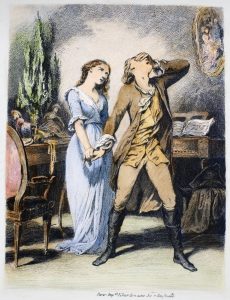Bach Chaconne, from Partita No.2 in D minor, BWV 1004 (1720)
Beethoven String Trio in G major, Op. 9 No.1 (1797-98)
Brahms Piano Quartet No. 3 in C minor, Op. 60 (1875)
The Chaconne is, in my opinion, one of the most wonderful and most incomprehensible pieces of music. Using the technique adapted to a small instrument, the man writes a whole world of the deepest thoughts and most powerful feelings. If I could picture myself writing, or even conceiving such a piece, I am sure that the extreme excitement and emotional tension would have driven me mad…
Johannes Brahms (who made a piano transcription of Bach’s Chaconne) in a letter to Clara Schumann
…[these] works of art which enjoy the honor of your patronage [are offered with] the greatest satisfaction [by this artist]…as the best of his works…to his first patron of his muse.
Beethoven’s dedication of Op. 9
On the cover you must have a picture, namely a head with a pistol to it. Now you can form some conception of the music!
Brahms writing to his publisher about Op. 60
Our February program consists of three works, favorites of BCMS audiences, by three who need no introduction. Each work has been described in superlatives—by one composer in admiration of another; in humble recognition of a divine gift; seriously, or in jest, as a way to spell out and alleviate immense emotional suffering.

As the fifth and final movement of Bach’s Partita No. 2 in D minor, Chaconne is a set of variations in triple meter above a repeated descending bass line. It is a work of towering ingenuity that evokes such deep thoughts and powerful feelings that it makes the similarly structured Pachelbel Canon seem but a nursery rhyme. It is the longest of all the movements written for solo violin among the Partitas and Sonatas, and six solo cello Suites, inviting independent performances and more arrangements and accompaniments than perhaps any single piece in music history. Some of the best-known arrangers are Mendelssohn, Schumann, Brahms (for the left hand alone 1879), and Busoni. Brahms’s Symphony No. 4 (1886) concludes with a movement based on similar variation design. For all its apparent gravitas and grandeur:
There is reason to believe that the chaconne originally was a wild and sensual Mexican dance that was imported into Spain during the 16th century. Surviving from 1599 is “An invitation to go to Tampico in Mexico and there dance the chacona.
Harvard Dictionary of Music (1973) pg. 142
Although not his first string trio, or earliest work to receive patronage as Beethoven’s dedication might suggest, String Trio Op. 9, No.1 is probably the most often played and remains unsurpassed by the six earliest string quartets to follow as Op. 18 within the same year. It is a work in four conventional classical movements, but packed with the kind of virtuosity and playfulness that befits an ensemble where each instrument is the only one of its kind.
Dating from twelve years after publishing his first two, Brahms’s C minor Piano Quartet is his third and final. It acquired the nickname Werther for the principal character of Goethe’s tragic novel whom Brahms referenced as a casualty of unrequited love and the source of the brooding nature of the music. Brahms’s unfulfilled passion was for Clara Schumann, wife of composer Robert, and the mother of their eight children. In this work her first name is spelled out repeatedly in sighing notes and in transposed phrases that leave little doubt about the subject and object of this otherwise wordless medium.

A recording of this powerful work played by BCMS musicians is available for purchase on compact in the lobby.
Enjoy,
Marcus
